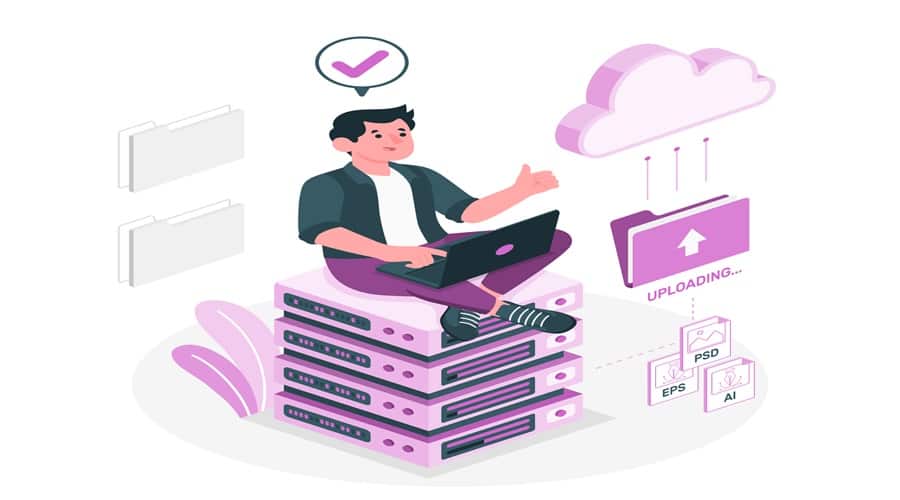
Server Backup Software: Safeguarding Your Critical Data
In present-day data-pushed international, groups of all sizes rely heavily on their servers to save and manage project-critical data. From customer databases and monetary data to proprietary packages and highbrow property, the loss or corruption of server statistics can have intense consequences for corporations. That is where server backup software comes into play, presenting a strong and dependable strategy to protect against information loss, system screw-ups, and potential disasters.
What is Server Backup Software?
Server backup software is a specialized application designed to create and manage backup copies of data stored on servers. It allows organizations to regularly and systematically copy server data to a separate storage location, including files, databases, and system configurations. This ensures that in the event of a system failure, data corruption, or other unforeseen circumstances, the backed-up data can be restored, minimizing downtime and data loss.
Importance of Server Backup Software
The importance of server backup software cannot be overstated, as it provides numerous benefits to organizations:
Data Protection:
Server backup software safeguards critical data from accidental deletion, hardware failures, cyber threats, and natural disasters, ensuring business continuity and preserving valuable information assets.
Disaster Recovery:
In a catastrophic event, server backup software enables organizations to quickly restore their data and systems, minimizing downtime and associated costs. This rapid recovery capability is essential for maintaining operations and mitigating financial losses.
Regulatory Compliance:
Many industries have strict data retention and backup requirements imposed by regulatory bodies. Server backup software helps organizations meet these obligations by ensuring that data is securely backed up and accessible for compliance audits.
Cost-Effectiveness:
Enforcing a dependable server backup solution is often more powerful than dealing with the results of statistics loss. The fees related to misplaced productivity, sales loss, and reputational damage some distance outweigh the funding required for a sturdy backup strategy.
Peace of Mind:
With a strong server backup strategy in the area, businesses could have peace of mind, understanding that their vital information is protected and recoverable in case of unforeseen events. This self-belief allows companies to recognize their middle sports besides the steady fear of data loss or device screw-ups.
Key Features to Consider
When evaluating server backup software, it’s important to consider the following key features:
Backup Types:
Ensure the software supports various backup types, including full, incremental, differential, and continuous data protection backups. This flexibility allows for tailored backup strategies based on data criticality and resource availability.
Scheduling and Automation:
Look for software that allows you to schedule backups and automate the process. This feature ensures backups are conducted regularly and consistently without manual intervention, enhancing data protection and operational efficiency.
Data Compression and Deduplication:
Opt for software with data compression and deduplication capabilities. These features help reduce backup storage space requirements by eliminating redundant data and optimizing backup performance, especially for environments with limited storage resources.
Encryption and Security:
Prioritise software that implements robust encryption and security measures to protect sensitive data during backup and restore processes. Encryption safeguards data confidentiality, integrity, and authenticity, ensuring compliance with security standards and regulations.
Central Management Console:
Choose software with a centralized management console for streamlined administration and monitoring of backup operations across multiple servers. A centralized console provides a unified view of backup activities, simplifies configuration management, and enhances overall operational efficiency.
Reporting and Alerts:
Select software that offers comprehensive reporting and alert capabilities. Detailed reports allow administrators to track backup activities, monitor performance metrics, and assess compliance with backup policies. Alerts promptly notify administrators of backup failures or issues, enabling timely troubleshooting and resolution.
Factors to Consider When Choosing Server Backup Software
Selecting the right server backup software for your organization involves careful consideration of several factors:
Business Size and Requirements:
Assess your organization’s size, the number of servers to be backed up, and any specific backup requirements or compliance needs to ensure the chosen software can effectively meet these demands.
Backup Frequency and Data Volume:
Determine the required backup frequency and the volume of data to be backed up. This information will influence the software’s performance and storage requirements, ensuring it can handle the workload efficiently.
Operating System and Application Support:
Ensure the server backup software supports your IT environment’s operating systems and applications. Compatibility with your existing infrastructure is essential for seamless integration and reliable backups.
Scalability and Growth Plans:
Consider your organization’s growth plans and select a scale solution for future backup needs. Scalability ensures the software remains effective as your organization expands, preventing the need for frequent software migrations.
Backup Storage Options:
Evaluate available backup storage options, such as on-premises, cloud, or hybrid solutions, and choose the one that best fits your organization’s requirements and budget. Flexibility in storage options allows you to tailor backup solutions to your specific needs.
Ease of Use and Administration:
Look for software with a user-friendly interface and streamlined administration to simplify backup management. Intuitive tools and centralized dashboards reduce the learning curve for IT staff, increasing operational efficiency and minimizing the risk of errors.
Support and Vendor Reputation:
Consider the vendor’s reputation, customer support offerings, and the availability of training and resources. A reputable vendor with strong customer support ensures a smooth implementation process and provides reliable assistance for any issues arising during operation.
Implementation and Best Practices
Implementing server backup software is a critical process that requires careful planning and execution. Here are some best practices to consider:
Conduct a Thorough Assessment:
Begin by assessing your organization’s backup needs, including data volumes, data recovery objectives, and compliance requirements. This assessment will help determine the appropriate backup strategy and software requirements tailored to your organization’s needs.
Develop a Backup Plan:
Create a complete backup graph that outlines the backup schedule, retention guidelines, garage places, and healing methods. Truly outline roles and duties within your IT team to ensure easy execution of the backup layout.
Test and Validate Backups:
Regularly test and validate your backup processes to ensure data integrity and verify that backups can be restored. Testing should include full system restores and individual file recoveries to ensure the backup system functions as expected.
Train IT Staff:
Provide adequate training to IT staff on properly using and administering the server backup software. Training should cover backup policies, procedures, and best practices to ensure effective backup management and response to backup-related issues.
Monitor and Optimize:
Monitor backup operations, performance, and storage utilization to identify potential issues or bottlenecks. Regularly review backup logs and reports to ensure backups are completed successfully and within the defined backup windows. Make necessary optimizations to maintain an efficient and reliable backup system, such as adjusting backup schedules or upgrading hardware.
Backup Storage Options
When implementing server backup software, organizations have several storage options to consider:
On-Premises Storage:
This involves storing backups on local storage devices, such as hard drives, tape libraries, or network-attached storage (NAS) systems, within the organization’s premises. On-premises storage provides direct control over data and can offer fast backup and recovery times for local resources.
Cloud Storage:
Cloud-based storage solutions offer scalable and cost-effective options for storing backups off-site. By leveraging the cloud, organizations can benefit from increased flexibility, accessibility, redundancy, and protection against localized disasters. Cloud storage also eliminates the need to maintain on-premises hardware, reducing capital expenditure and administrative overhead.
Hybrid Storage:
A hybrid approach combines on-premises and cloud storage, allowing organizations to store critical backups off-site while keeping frequently accessed data locally for faster recovery. This approach offers the benefits of both on-premises and cloud storage, balancing performance, scalability, and resilience. It enables organizations to leverage the advantages of cloud storage while retaining control over sensitive data and optimizing recovery times for local resources.
Disaster Recovery Planning
Server backup software is essential to an organization’s disaster recovery plan. A well-designed disaster recovery plan should include:
Detailed Recovery Procedures:
They documented step-by-step procedures for restoring data and systems from backups in a disaster. These procedures should outline the actions to be taken, including initiating backups, recovering data, and restoring critical systems and services.
Healing Time and recuperation factor targets (RTOs and RPOs):
Clearly define recovery time objectives (RTOs) and recovery point objectives (RPOs) to establish acceptable timeframes for restoring operations and data. RTOs specify the maximum tolerable downtime for critical systems, while RPOs define the maximum acceptable data loss.
Testing and Drills:
Regularly conduct testing and drills to validate the effectiveness of the disaster recuperation format and perceive any ability gaps or regions for development. Trying out needs to consist of simulated catastrophe scenarios to assess the readiness of IT personnel and the adequacy of backup and recovery procedures.
Roles and responsibilities:
Certainly, outline roles and responsibilities for IT groups of workers and different stakeholders worried about the disaster restoration method. Assign particular duties, consisting of backup control, healing coordination, and verbal exchange with stakeholders, to ensure a coordinated reaction during a catastrophe.
Cost Analysis and Budgeting
Software Licensing Costs:
Evaluate the upfront and ongoing licensing costs for the server backup software. Some vendors offer subscription-based pricing models, while others may charge a one-time fee for perpetual licenses. Additionally, consider any additional fees for support or maintenance contracts.
Hardware and Storage Costs:
If implementing on-premises storage, factor in the costs of purchasing and maintaining storage hardware. This may include hard drives, tape libraries, or network-attached storage (NAS) systems. Assess the scalability and performance of hardware solutions to ensure they can accommodate growing backup needs.
Cloud Storage Costs:
Consider the recurring costs of cloud storage and data transfer fees for cloud-based or hybrid solutions. Evaluate different cloud providers and storage tiers to find a cost-effective solution that meets your organization’s backup requirements.
Implementation and Training Costs:
Account for any professional services or training costs required for successful implementation and staff training. This may include consulting services for initial setup, configuration, and training programs to familiarise IT staff with the backup software’s features and best practices.
Ongoing Maintenance and Support:
Budget for ongoing maintenance, support, and potential upgrades to ensure the backup solution remains up-to-date and effective. Consider the vendor’s support offerings, including response times, availability of technical support resources, and any associated costs for premium support plans.
Tools For Server Backup Software
Veeam Backup & Replication:
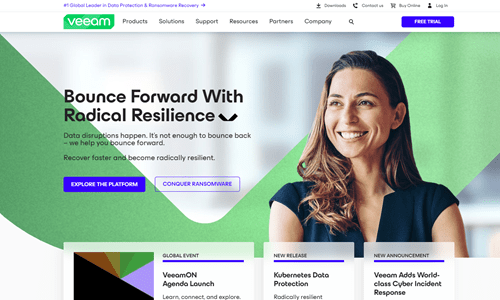
Description:
Veeam Backup & Replication offers comprehensive data protection and disaster recovery for virtual, physical, and cloud-based workloads. It provides features such as backup, replication, and restoration with enterprise-grade reliability and scalability.
Pros:
User-friendly interface, flexible deployment options, advanced backup and replication features, and various platforms and environments support.
Cons:
Higher pricing for enterprise-level features may require additional resources for large-scale deployments.
Used For:
Backup and replicating virtual, physical, and cloud-based servers, disaster recovery planning, and data protection for VMware vSphere and Microsoft Hyper-V environments.
Pricing Package:
Veeam offers various pricing packages tailored to businesses’ needs, including per-socket licensing for virtual environments and subscription-based pricing for cloud and physical server backups.
Acronis Backup:
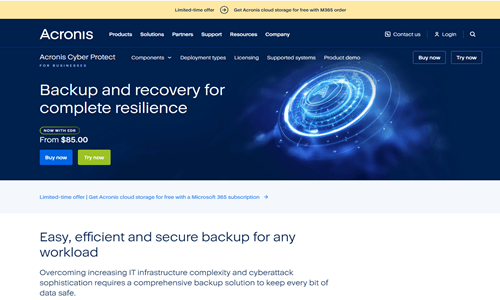
Description:
Acronis Backup provides comprehensive backup and recovery solutions for servers, workstations, and virtual environments. It offers image-based backups, granular recovery options, and cloud integration for secure off-site storage.
Pros:
Wide range of backup options, efficient data deduplication and compression, multi-platform support, and easy-to-use management console.
Cons:
They limited customization options for advanced users and occasional performance issues during large-scale backups.
Used For:
Backup and restoration of physical and digital servers, disaster restoration planning, and data safety for home Windows and Linux environments.
Pricing Package:
Acronis offers flexible pricing options based on the number of servers and the required features, including perpetual licenses and subscription-based models.
Commvault Complete Backup & Recovery:
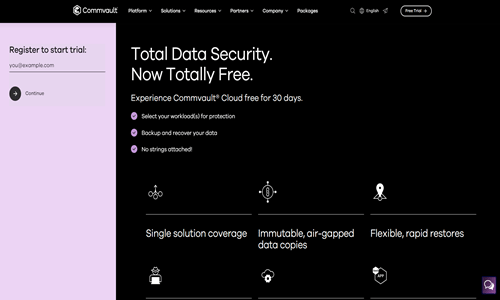
Description:
Commvault Complete Backup & Recovery is a comprehensive data protection and management platform that offers backup, recovery, and data management capabilities for servers, endpoints, and cloud workloads.
Pros:
Unified data management platform, advanced data deduplication and compression, comprehensive backup and recovery features, and integration with leading cloud providers.
Cons:
Complex setup and configuration processes and the higher learning curve for new users may require additional hardware resources for large-scale deployments.
Used For:
Backup and recovery of servers, endpoints, cloud workloads, disaster recovery planning, and data protection for heterogeneous environments.
Pricing Package:
Commvault offers customized pricing based on businesses’ specific requirements, including perpetual licenses, subscription-based models, and capacity-based pricing options.
Backup Exec:
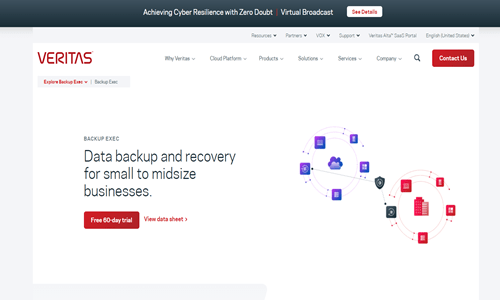
Description:
Backup Exec is a trusted backup and recovery solution for small—to medium-sized businesses. It offers automated backups, deduplication, and cloud integration, providing reliable data protection for physical and virtual environments.
Pros:
It offers a user-friendly interface, fast and efficient backups, various operating systems and applications support, and seamless integration with cloud storage providers.
Cons:
Limited scalability for large enterprise environments occasional compatibility issues with newer operating systems or applications.
Used For:
Backup and healing of physical and virtual servers, catastrophe recovery planning, and data safety for Windows and Linux environments.
Pricing Package:
Backup Exec offers flexible pricing options based on the number of servers and the required features, including perpetual licenses and subscription-based models.
Carbonite Server Backup:
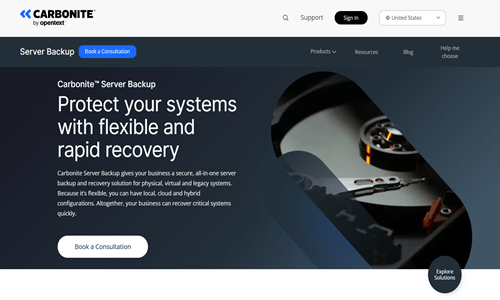
Description:
Carbonite Server Backup is a cloud-based backup solution designed for businesses of all sizes. It offers automated backups, continuous data protection, and easy-to-use management tools, ensuring data availability and security during system failures or disasters.
Pros:
Simple setup and configuration, continuous data protection with minimal impact on system performance, secure cloud storage with encryption and redundancy.
Cons:
Confined customization picks for superior customers, higher pricing for large garage capacities, or extra features.
Used For:
Backup and healing of bodily and digital servers, catastrophe healing planning, statistics safety for home windows and Linux environments.
Pricing Package:
Carbonite Server Backup offers subscription-based pricing tailored to businesses’ storage needs. It offers options for flexible retention periods and advanced features such as bare-metal recovery and granular file-level restores.
Future Trends in Server Backup Software
Artificial Intelligence and Machine Learning:
Expect AI and ML technologies to be integrated into server backup software, enhancing efficiency by optimizing backup processes, recognizing data patterns, and forecasting potential issues or failures.
Increased Cloud Integration:
With the growing adoption of cloud computing, server backup software will likely offer deeper integration with cloud platforms and services. This integration will streamline backup and recovery processes and facilitate seamless data management across hybrid environments.
Containerization and Virtualization Support:
As containerized and virtualized environments become more prevalent, backup software must provide robust support for backing up and restoring these workloads. Look for features tailored to container orchestration platforms and hypervisors.
Cyber Resiliency and Ransomware Protection:
Expect server backup software to incorporate advanced cyber resiliency features to safeguard backups from ransomware attacks and ensure data integrity. This may include immutable backups, anomaly detection, and automated recovery workflows.
Edge Computing and IoT Support:
As part computing and Internet of Things (IoT) gadgets gain traction, backup software should cope with these distributed environments’ unique backup and recovery challenges. This includes efficient data capture, bandwidth optimization, and decentralized backup control solutions.
FAQs
What is server backup software, and why is it necessary?
A server backup software program is designed to routinely and securely create copies of facts stored on servers. It is imperative to guard treasured statistics from loss owing to accidental deletion, hardware failure, cyberattacks, or herbal screw-ups.
How does server backup software work?
Server backup software periodically scans server data and creates copies, often called backups, stored locally or in the cloud. These backups can be used to restore data in case of loss or corruption.
What are the key benefits of using server backup software?
The key benefits of using server backup software include data protection, disaster recovery capabilities, automation of backup processes, reduction of downtime, compliance with regulatory requirements, and peace of mind knowing that valuable data is securely backed up.
What forms of data can be subsidized through server backup software programs?
Server backup software can back up various data types, including files, databases, applications, system configurations, and virtual machines.
How often should I perform backups with server backup software?
The frequency of backups depends on factors, including the criticality of the data, the rate of change of the statistics, and the employer’s recovery point goals (RPOs). Ordinary backups are generally encouraged, with greater common backups for imperative records.
What are some common challenges or considerations when implementing server backup software?
Common challenges include selecting the appropriate backup solution for specific needs, ensuring compatibility with existing infrastructure, managing backup storage efficiently, addressing security concerns, testing backups regularly to ensure data recoverability, and staying compliant with data protection regulations.
Conclusion
In conclusion, server backup software is crucial for businesses of all sizes to protect their essential records and ensure commercial enterprise continuity. By automating the backup process, server backup software allows for mitigating the dangers associated with records loss due to different factors, such as failures, cyberattacks, or human errors. The advantages of server backup software include increased past statistics safety, advanced catastrophe restoration abilities, reduced downtime, and compliance with regulatory requirements. While imposing server backup software programs may also gift demanding situations, which include deciding on the proper solution and addressing security worries, the investment in robust backup answers, in the end, gives peace of thought. It permits corporations to pay attention to their middle targets besides worrying about dropping valuable statistics.




